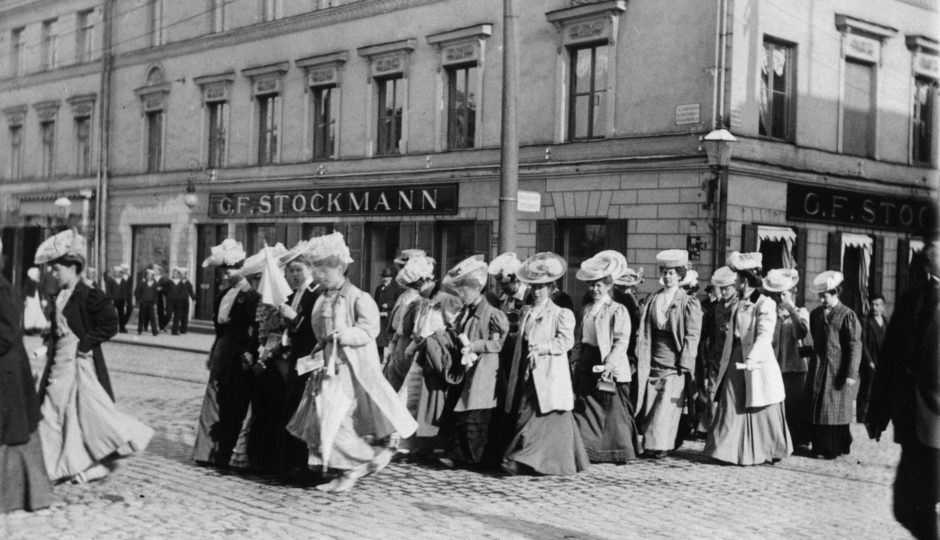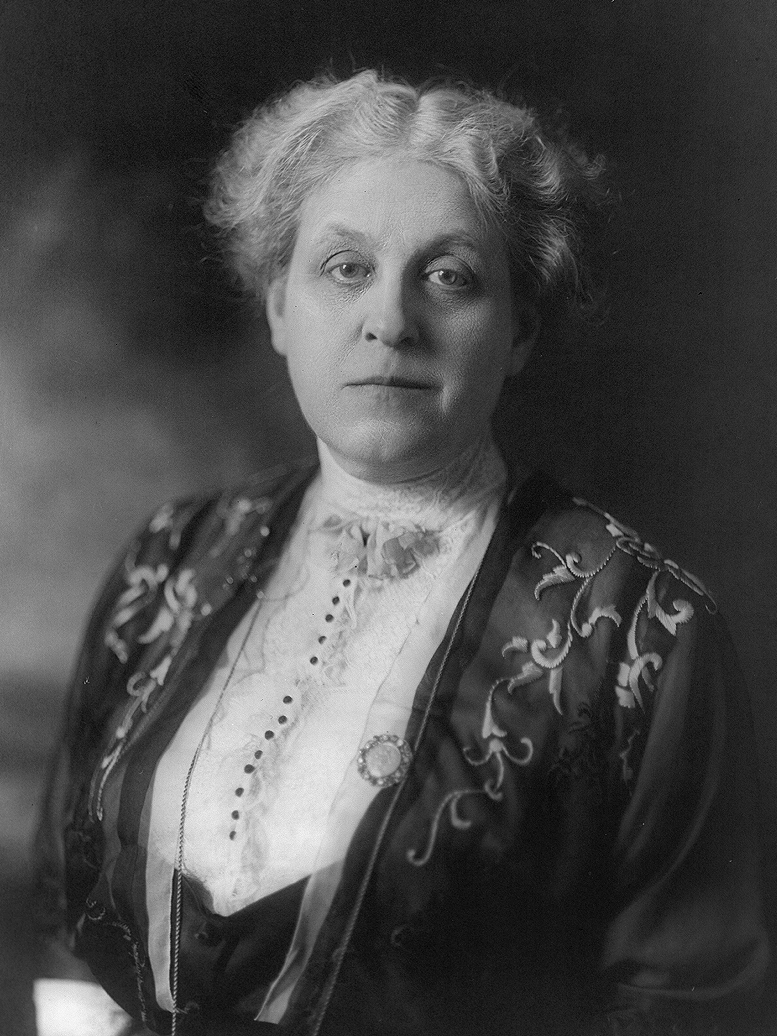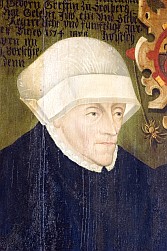|
Unioni Naisasialiito Suomessa Ry
Naisasialiitto Unioni (Finnish) or Kvinnosaksförbundet Unionen (Swedish), sometimes referred to in English as the League of Finnish Feminists, is a non-profit Finnish women's organization which was established in 1892. Since 1904 it has been the Finnish arm of the International Alliance of Women. The co-founders were Lucina Hagman, Maikki Friberg and Venny Soldan-Brofeldt. Unioni was initially concerned with women's voting rights (granted in 1906), equal pay, education and combatting prostitution. More recently, it has striven to improve the social status of women and to increase the number of women who are active in politics. Today the association exerts influence on political discussions, seeks to improve women's rights Women's rights are the rights and entitlements claimed for women and girls worldwide. They formed the basis for the women's rights movement in the 19th century and the feminist movements during the 20th and 21st centuries. In some countries, ... and ... [...More Info...] [...Related Items...] OR: [Wikipedia] [Google] [Baidu] |
International Alliance Of Women
The International Alliance of Women (IAW; french: Alliance Internationale des Femmes, AIF) is an international non-governmental organization that works to promote women's rights and gender equality. It was historically the main international organization that campaigned for women's suffrage. IAW stands for an inclusive, intersectional and progressive liberal feminism. IAW's principles state that all genders are "born equally free nd areequally entitled to the free exercise of their individual rights and liberty," that "women’s rights are human rights" and that "human rights are universal, indivisible and interrelated." IAW is traditionally the dominant international non-governmental organization within the liberal (or bourgeois) women's movement. The basic principle of IAW is that the full and equal enjoyment of human rights is due to all women and girls. It is one of the oldest, largest and most influential organizations in its field. The organization was founded as the Int ... [...More Info...] [...Related Items...] OR: [Wikipedia] [Google] [Baidu] |
Lucina Hagman
Lucina Hagman (5 June 1853, Kälviä – 6 September 1946) was an early Finnish feminist and among the first female MPs in the world due to the 1907 Finnish parliamentary election. Life and career Hagman was the daughter of police master Nils Johan Erik Hagman and Margareta Sofia Nordman, a police chief in rural Kälviä. She was the sister of the educator Sofia Hagman and writer Tycho Hagman. She became a teacher and Jean Sibelius might be the most famous individuals to study at her school. She became active in women's causes serving in Parliament from 1907 to 1917. Of the 200 MPs elected in 1907 just 19 were women. The successful women included Hagman, Miina Sillanpää, Anni Huotari, Hilja Pärssinen, Hedvig Gebhard, Ida Aalle, Mimmi Kanervo, Eveliina Ala-Kulju, Hilda Käkikoski, Liisi Kivioja, Sandra Lehtinen, Dagmar Neovius, Maria Raunio, Alexandra Gripenberg, Iida Vemmelpuu, Maria Laine, Jenny Nuotio and Hilma Räsänen./ Lucina Hagman also founded the Martha or ... [...More Info...] [...Related Items...] OR: [Wikipedia] [Google] [Baidu] |
Maikki Friberg
Maria (Maikki) Elisabeth Friberg (1861–1927) was a Finnish educator, journal editor, suffragist and peace activist. She is remembered for her involvement in the Finnish women's movement, especially as chair of the Finnish women's rights organisation Suomen Naisyhdistys and as the founder and editor of the women's journal ''Naisten Ääni'' (Women's Voice). She travelled widely, promoting understanding of Finland abroad while participating in international conferences and contributing to the foreign press. Biography Born on 5 January 1861 in Kankaanpää, Maria Elisabeth Friberg was the daughter of Karl Arvid Friberg and Fanny Adelaide Boijer. After her father's early death, her mother moved with the children to Tammerfors where she opened a guest house. Friberg attended the Swedish School for Women in Helsinki where she matriculated from the teacher training class. In 1883, Friberg obtained a teaching post in Helsinki's folk high school which she held until 1912. She studied in ... [...More Info...] [...Related Items...] OR: [Wikipedia] [Google] [Baidu] |
Venny Soldan-Brofeldt
Wendla Irene Soldan-Brofeldt, known as Venny (2 November 1863, Helsinki – 10 October 1945, Lohja) was a Finnish painter, illustrator, graphic artist, wood sculptor and jewelry designer. She belonged to the Swedish speaking population of Finland. Kaija Valkonen – Elina Koivunen s. 96. Biography She was born as Wendla Irene Soldan. Her father, was the Director of the Mint of Finland. Her mother, Marie Müller (1837–1927), was German. Swedish was spoken at home. Her desire to become an artist received her family's wholehearted support.Riitta Konttinen s. 18–19 From 1880 to 1884, she initially attended the drawing school of the Finnish Art Association (now the Academy of Fine Arts), but also studied privately with Maria Wiik and attended classes in St.Petersburg from 1883 to 1885. She was briefly a student at the Académie Colarossi in Paris on two occasions. She also made study trips to Spain and Italy with the money she earned copying old classics. Upon returning to Hel ... [...More Info...] [...Related Items...] OR: [Wikipedia] [Google] [Baidu] |
Women's Suffrage
Women's suffrage is the right of women to vote in elections. Beginning in the start of the 18th century, some people sought to change voting laws to allow women to vote. Liberal political parties would go on to grant women the right to vote, increasing the number of those parties' potential constituencies. National and international organizations formed to coordinate efforts towards women voting, especially the International Woman Suffrage Alliance (founded in 1904 in Berlin, Germany). Many instances occurred in recent centuries where women were selectively given, then stripped of, the right to vote. The first place in the world to award and maintain women's suffrage was New Jersey in 1776 (though in 1807 this was reverted so that only white men could vote). The first province to ''continuously'' allow women to vote was Pitcairn Islands in 1838, and the first sovereign nation was Norway in 1913, as the Kingdom of Hawai'i, which originally had universal suffrage in 1840, r ... [...More Info...] [...Related Items...] OR: [Wikipedia] [Google] [Baidu] |
Equal Pay
Equal pay for equal work is the concept of labour rights that individuals in the same workplace be given equal pay. It is most commonly used in the context of sexual discrimination, in relation to the gender pay gap. Equal pay relates to the full range of payments and benefits, including basic pay, non-salary payments, bonuses and allowances. Some countries have moved faster than others in addressing equal pay. Early history As wage-labour became increasingly formalized during the Industrial Revolution, women were often paid less than their male counterparts for the same labour, whether for the explicit reason that they were women or under another pretext. The principle of equal pay for equal work arose at the same part of first-wave feminism, with early efforts for equal pay being associated with nineteenth-century Trade Union activism in industrialized countries: for example, a series of strikes by unionized women in the UK in the 1830s. Pressure from Trade Unions has had vari ... [...More Info...] [...Related Items...] OR: [Wikipedia] [Google] [Baidu] |
Women's Rights
Women's rights are the rights and entitlements claimed for women and girls worldwide. They formed the basis for the women's rights movement in the 19th century and the feminist movements during the 20th and 21st centuries. In some countries, these rights are institutionalized or supported by law, local custom, and behavior, whereas in others, they are ignored and suppressed. They differ from broader notions of human rights through claims of an inherent historical and traditional bias against the exercise of rights by women and girls, in favor of men and boys.Hosken, Fran P., 'Towards a Definition of Women's Rights' in ''Human Rights Quarterly'', Vol. 3, No. 2. (May 1981), pp. 1–10. Issues commonly associated with notions of women's rights include the right to bodily integrity and autonomy, to be free from sexual violence, to vote, to hold public office, to enter into legal contracts, to have equal rights in family law, to work, to fair wages or equal pay, to have reproduct ... [...More Info...] [...Related Items...] OR: [Wikipedia] [Google] [Baidu] |
Liberal Feminist Organizations
Liberal or liberalism may refer to: Politics * a supporter of liberalism ** Liberalism by country * an adherent of a Liberal Party * Liberalism (international relations) * Sexually liberal feminism * Social liberalism Arts, entertainment and media * ''El Liberal'', a Spanish newspaper published 1879–1936 * ''The Liberal'', a British political magazine published 2004–2012 * ''Liberalism'' (book), a 1927 book by Ludwig von Mises * "Liberal", a song by Band-Maid from the 2019 album '' Conqueror'' Places in the United States * Liberal, Indiana * Liberal, Kansas * Liberal, Missouri * Liberal, Oregon Religion * Religious liberalism * Liberal Christianity * Liberalism and progressivism within Islam * Liberal Judaism (other) See also * * * Liberal arts (other) * Neoliberalism, a political-economic philosophy * The Liberal Wars The Liberal Wars (), also known as the Portuguese Civil War (), the War of the Two Brothers () or Miguelite War (), was a war bet ... [...More Info...] [...Related Items...] OR: [Wikipedia] [Google] [Baidu] |
Organizations Established In 1892
An organization or organisation (Commonwealth English; see spelling differences), is an entity—such as a company, an institution, or an association—comprising one or more people and having a particular purpose. The word is derived from the Greek word ''organon'', which means tool or instrument, musical instrument, and organ. Types There are a variety of legal types of organizations, including corporations, governments, non-governmental organizations, political organizations, international organizations, armed forces, charities, not-for-profit corporations, partnerships, cooperatives, and educational institutions, etc. A hybrid organization is a body that operates in both the public sector and the private sector simultaneously, fulfilling public duties and developing commercial market activities. A voluntary association is an organization consisting of volunteers. Such organizations may be able to operate without legal formalities, depending on jurisdiction, incl ... [...More Info...] [...Related Items...] OR: [Wikipedia] [Google] [Baidu] |
1892 Establishments In Finland
Year 189 ( CLXXXIX) was a common year starting on Wednesday (link will display the full calendar) of the Julian calendar. At the time, it was known as the Year of the Consulship of Silanus and Silanus (or, less frequently, year 942 '' Ab urbe condita''). The denomination 189 for this year has been used since the early medieval period, when the Anno Domini calendar era became the prevalent method in Europe for naming years. Events By place Roman Empire * Plague (possibly smallpox) kills as many as 2,000 people per day in Rome. Farmers are unable to harvest their crops, and food shortages bring riots in the city. China * Liu Bian succeeds Emperor Ling, as Chinese emperor of the Han Dynasty. * Dong Zhuo has Liu Bian deposed, and installs Emperor Xian as emperor. * Two thousand eunuchs in the palace are slaughtered in a violent purge in Luoyang, the capital of Han. By topic Arts and sciences * Galen publishes his ''"Treatise on the various temperaments"'' (aka ... [...More Info...] [...Related Items...] OR: [Wikipedia] [Google] [Baidu] |
Women's Rights Organizations
A woman is an adult female human. Prior to adulthood, a female human is referred to as a girl (a female child or adolescent). The plural ''women'' is sometimes used in certain phrases such as "women's rights" to denote female humans regardless of age. Typically, women inherit a pair of X chromosomes, one from each parent, and are capable of pregnancy and giving birth from puberty until menopause. More generally, sex differentiation of the female fetus is governed by the lack of a present, or functioning, SRY-gene on either one of the respective sex chromosomes. Female anatomy is distinguished from male anatomy by the female reproductive system, which includes the ovaries, fallopian tubes, uterus, vagina, and vulva. A fully developed woman generally has a wider pelvis, broader hips, and larger breasts than an adult man. Women have significantly less facial and other body hair, have a higher body fat composition, and are on average shorter and less muscular than men. Throu ... [...More Info...] [...Related Items...] OR: [Wikipedia] [Google] [Baidu] |







.jpg)